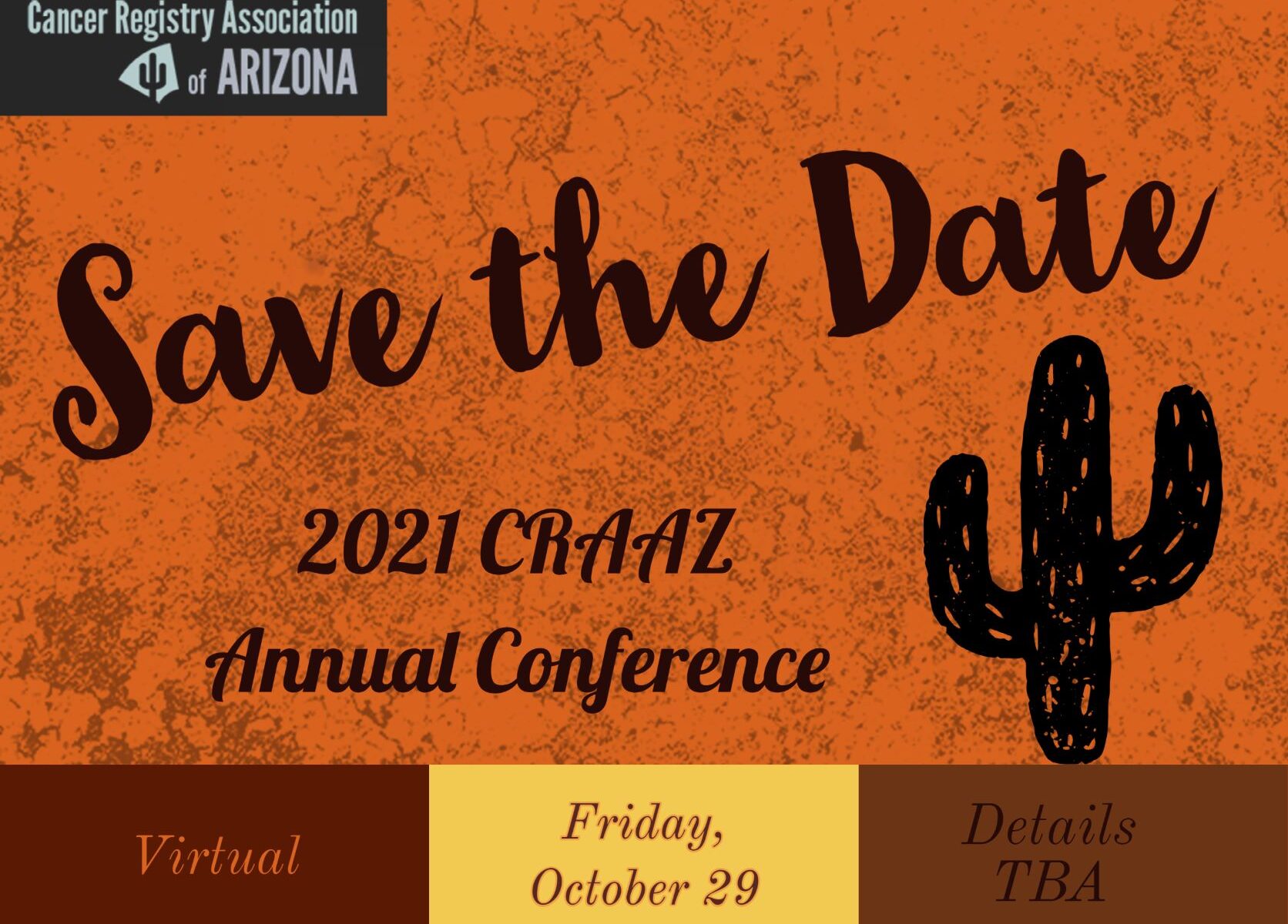
2019 CRAAZ Annual Education Conference was a success!
Date: November 20th 2019
Location: Dignity Health
St. Joseph Hospital & Medical Center
SONNTAG Pavilion
350 W Thomas Road Phoenix AZ 85013
The meeting was a success…
CRAAZ was able to offer this meeting through webinar for the 1st time as well as on-site. Our presenters were fabulous and were able to address a lot of changes to the new rules in place.
Recognition to our NEW CTRs for 2018 & 2019.
Along with their recognition, they were given as a gift to passing the CTR exam free membership for 2020. CONGRATULATIONS to our NEW CTR’s!
2018 (Spring, Summer, Fall)
Emily Martin
Miriam Wilder-Hairston
Lisa Hall
Amanda Little
Lisa Broles
Michelle Lenzen
Kaleb Martorano
Sherry Willard
2019 (Spring, Summer, Fall is pending results)
Valeria Chorba
Elizabeth (Liz) Pulcini
Raffle Winners
Thia Nguyen – Starbucks donated from Elekta
Susan Sullivan – Starbucks w/coffee & tea donated from Registry Partners
Jill Herschel – Harkin’s family pack of 4
Melanie Zaleski – Wine
Early Bird Registration $50 Winner for 2019
Candi Carver
Vendors that Participated at the 2019 CRAAZ Conference
Elekta
Sonreg Solutions Inc.
Message from SEER and NAACCR
July 17, 2019
Solid Tumor Rules: July 2019 Update
Based on questions and continued suggestions from registrars and educators, the decision was made to update the applicable rules at this time. Most changes are minor: terminology, additional definitions, and new notes and examples. We recommend you read the
July 2019 Change Log to understand what changes were made.
Major changes
Lung H rule:
We identified an issue with lung histology reporting by pathologists and after consulting with our expert lung pathologist, determined that a rule should be added to specifically address this issue.
The new lung H rule address tumors with multiple types of adenocarcinoma and percentages of each type listed in the diagnosis. The original H rule instructed registrars to code adenocarcinoma, mixed types (8255/3). Per our lung expert, ICD-O code 8255/3 is
strongly discouraged. The new H rule provides instructions on coding the histology comprising the greatest percentage of tumor. Lung Table 2 (Combination histology codes) has also been updated to reinforce the new H rule.
Important: We strongly suggest you review lung cases diagnosed 1/1/2018 forward with code 8255/3 to determine if a specific histology code can be assigned based on the new H rule. By coding a specific histology rather than the mixed histology, you will be
able to assign stage.
Lung M rule:
A rule was added to address separate non-contiguous tumors, one with a combination code from Table 2 and one with a single histology from Table 3.
A comprehensive change log has also been posted for reference.
The updated rules published July 2019 apply to the following sites only:
• Breast
• Colon/Rectum
• Head & Neck
• Lung
• Kidney
• Malignant CNS
• Non-malignant CNS
• Urinary
The Solid Tumor Manual can be accessed at: https://seer.cancer.gov/tools/solidtumor/
Submit questions concerning the Solid Tumor Rules to Ask A SEER Registrar:
https://seer.cancer.gov/registrars/contact.html
2019 CRAAZ Annual Education Conference
Where is going to be?
Location: St. Joseph Hospital & Medical Center
SONNTAG Pavilion
350 W Thomas Road * Phoenix Arizona 85013
Date: November 20th, 2019, Wednesday
Time: 8:00 AM – 5:00 PM, Check-In at 7:00 AM
Fall 2016 Educational Conference Registration Open
Hear ye, hear ye!
Registration is now open for the Fall 2016 CRAAZ Educational Conference.
Early Bird discounts are available through 9/15/16. Regular registration rates are in effect 9/16/16-10/13/16. Late registration fees apply the day of the conference, so complete your registration early!
Continue reading “Fall 2016 Educational Conference Registration Open”
What is A Cancer Registrar?
If you want to know more about being a cancer registrar, this is a lovely video that touches on the profession, its people and its purpose.
https://www.youtube.com/watch?v=yXg9vafsBh4&feature=youtu.be
Arizona Cancer Profile

A 2009 study conducted on cancer rates in the state of Arizona analyzed the incidence of diagnosis, prevalence of type and mortality rates for residents suffering from cancer. Overall, the study concluded that Mojave County is the only county with a cancer rate higher than the national average, though the cancer rate in Mojave is falling. Graham, Greenlee, and Gila counties all presented rates similar to the U.S. average, while Apache, La Paz, Arizona, Cochise, Coconino, Maricopa, Navajo, Pima, Pinal, Santa Cruz, Yavapai, and Yuma counties all presented statistics lower than the country’s average. Many of these counties also showed declining cancer rates.
Melanoma rates among men in Arizona were higher than the U.S. average. Liver cancer among females and thyroid cancers in males were similar to the average, though both show signs of rising. Conversely, liver cancer in males in Arizona was lower than the national average.
A number of cancers in Arizona were similar to the national average and were found to be a stable trend. These included brain cancer in both males and females, esophagus cancer in males and females, kidney and renal pelvis cancer in males and females, and ovarian cancer in females.
Childhood cancer in Arizona was also similar to the national average; however, the study found the incidences of childhood cancer was declining in 2009. Leukemia in females was also in decline, as was female melanoma and Non-Hodgkin lymphoma in females.
Other cancers that were lower than the national average and showed signs of continued decline, include bladder cancer in both males and females, breast cancer in females, cervical cancer in females, colorectal cancer in males and females, leukemia in males, lung cancer in males and females, oral cancer in males and females, pancreatic cancer in males, prostate cancer in males, and stomach cancer in males and females.
In comparison to the rest of the country, Arizona met the healthy people objective of 160.6 and had a falling mortality rate for cancer. The United States as a whole did not meet the objective but did observe a falling mortality rate. Only four counties in Arizona failed to meet the objective – Greenlee, Mojave, Gila, and Graham. Greenlee and Graham counties saw a stable trend in their mortality rates while Mojave and Gila have begun to see a decline in their cancer mortality rates, according to the 2009 study.
Personal Information Collected by Cancer Registrars

Cancer registries are an integral part of anti-cancer efforts, as they assist physicians in formulating treatment plans, researchers in creating abstracts, and academics in educating the public about cancer causes, treatment, and prevention methods.
If you are struggling with cancer, your information may be added to a registry to assist in controlling and preventing cancer. While it is entirely natural to worry about what sort of personal information is recorded, none of it is identifying and the information is solely used to aide in creating accurate, timely statistics related to cancer.
Demographic Information
Demographic information collected by a cancer registry includes your age, gender, race and ethnicity, place of birth, and place of residence. This information is helpful for tracking cancer statistics across age, differences in prevalence between males and females, prevalence in different races, and cancer rates in different cities.
Medical History
Your medical history information will include physical findings, screening information, your occupation, and any history you or a family member may have of cancer previously. Medical history is one of the most important elements in cancer registry data, and is highly effective in helping registrars identify and analyze patterns between patients. For example, mesothelioma has been linked specifically to patients who previously worked around asbestos through work performed by cancer registries.
Diagnostic Findings
Diagnostic findings collected include information relative to how you were diagnosed. This includes the type of cancer you have been diagnosed with, the date of your diagnosis, and the results of the procedures that were used to diagnose your cancer. This information helps registrars analyze the prevalence of specific cancer types and pinpoint the best procedures for diagnosing each type specifically.
Cancer Information
Information directly related to your cancer will be collected, including the primary site, cell type, and extent of the disease. This is useful for identifying common primary sites for each type of cancer and when combined with information about the date of diagnosis, analyzing the pace at which each type of cancer progresses.
Cancer Therapy
Regardless of the treatment(s) you undergo for your cancer, data will be collected for the registry, such as surgery, chemotherapy, radiation therapy, hormone therapy, and immunotherapy. Information about cancer therapy helps registrars identify how effective different treatments are for different types of cancer.
Follow-up Information
As you continue through your cancer treatment into remission, registries still collect data about your progress. This includes updates to your status, updates to your treatment plan, and recurrence, if applicable.
The Purpose of Cancer Registrars

Cancer registrars are important members of the anti-cancer movement, as they serve as experts in both data collection and data analysis related to all forms of cancer. They collect information about patient histories, diagnoses, treatments, and statuses; then translate the information into statistics for future studies. These statistics are reported to various healthcare agencies, including oncologists, administrators, researchers, and healthcare planners. The data collected by cancer registrars is intended to help oncologists and other healthcare professionals work toward the ultimate goal of controlling and preventing cancer.
What Types of Data are Compiled?
Cancer registrars are in charge of researching and compiling data in a timely manner, while ensuring that all of their findings are accurate. Generally, they compile and maintain information on all types of cancer being diagnosed or treated within an institution or specific population. They put together complete summaries for each patient that begin at the time of diagnosis and continue on through their lifetime. The ultimate goal is to create a registry that tracks each patient’s history individually, as well as an overall profile that shows information for all patients included in the registry. Thanks to modern technology, cancer registrars use electronic databases and computer software to help them input, track, and analyze the data they collect.
Who do Cancer Registrars Share Information With?
Often working closely with cancer programs and institutions, cancer registrars are usually an active part of the leadership structure of the facilities that employ them. They monitor the overall quality of patient care, ensure that treatments are meeting clinical practice guidelines, assess patterns of care, and monitor side effects, along with adverse outcomes of treatments. Oncologists use information collected by cancer registrars to create and evaluate treatment plans for patients; researchers often use the statistics cancer registrars compile as a starting point for their hypotheses. The data is also a valuable resource for educating the public about the incidence and outcomes of many different types of cancer.
Cancer registrars may find employment in healthcare facilities, central registries, consulting firms, government agencies, insurance companies, pharmaceutical companies and other healthcare industries.
Who is Eligible to Operate a Cancer Registrar?
Cancer registrars are run by a board of directors who either trained on-the-job or attended college programs in cancer data management. College programs provide aspiring registrar members with a strong foundation of knowledge in data collection methods, medical terminology, biostatistics, and cancer data abstracting. Many not-for-profit organizations earn certification from the National Cancer Registrars Association, which also offers a variety of benefits and resources to members to help them throughout their research.

